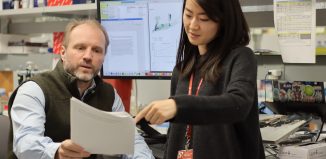BNL’s Watson’s air studies protect public health
Amid the moving chaos of New York City, Thomas Watson has stopped and watched the steam that rises out of manholes. On one side of the street, the steam drifted one way.
On the other, it headed in the opposite direction.
While the complexity of the wind might seem fitting for a city where people blow in from all over the world, the shifting air currents are much more than a metaphor to the chemist from Brookhaven National Lab. They have become a part of research he — and emergency management personnel in the city — use to understand how gases, particularly toxic or dangerous ones, might move through the street canyons created by buildings of all shapes and sizes.
In 2005, Watson conducted an extensive study of air currents in and around the city. He released perfluorocarbons at different points throughout the area, tracked where the gases went and put together how they might have gotten from one place to another.
This year, he’s starting another similar study. His work, which in 2005 was funded in part by the Department of Homeland Security, is designed to help emergency management crews in the city deal with an accidental release of gases that might pose a threat to public safety. The city also uses his research in the event of the intentional release of harmful substances.
“The research we do supports emergency response decision making,” said Watson.
Watson leads a unit at BNL called the Tracer Technology Group. They release harmless gases to see how different elements travel under a broad range of meteorological conditions.
The gases, called perfluorocarbons, are “totally nonreactive” and can be detected at incredibly low levels: parts per quadrillion.
Tracer gases are sometimes used across much larger areas than a metropolitan region as well.
“We can get an idea of how air is moving across the continent,” he suggested.
In the Across North America Tracer Experiment (Anatex) in the late 1980s, for example, gases released from Glasgow, Montana and St. Cloud, Minn., could be seen on the East Coast.
The science of tracking air movements using tracer compounds as they move across different terrains started about 30 years ago, Watson recalled, as part of a comprehensive safety plan amid the development of nuclear power plants. While a release from a plant is unlikely, “prudence dictates we should be able to predict where a release would go,” Watson offered.
Watson also studies indoor air quality, looking at infiltration rates into buildings. The ventilation systems of large buildings, he explained, often bring outside air into the system at a measured rate.
This work not only has implications for safety and public health, but also for energy efficiency, as buildings can use the data he collects to figure out whether more outside air than anticipated is entering the building. On a particularly hot or cold day, the introduction of outside air could raise heating or cooling costs.
Watson has also been involved in finding leaks in underground systems for utility companies. In some of the subterranean systems, power companies have underground wires that are surrounded by oil, which helps insulate and provide some cooling. When the oil leaks, it’s difficult to find. Enter perfluorocarbons.
“We ride around in a van and can find [the perfluorocarbons],” he described. By tracking the gases, “we can come within a couple of feet of the leak.”
The alternative to using the tracer chemicals is to freeze the line and see where the pressure drops. The freeze method sometimes requires digging several holes before finding the leak.
Tracer gases are also “important for climate work,” Watson offered. He looks at the exchange between the biosphere and the atmosphere. He validates transport models used to help interpret carbon dioxide exchange measurements.
When Watson, who lives in Ridge with his wife Phyllis, isn’t tracking gases through the air or underground, he enjoys spin casting for striped bass. He said he usually keeps one a season.
Although he grew up in Delaware and was a Phillies fan, he has seen the error of his ways and, after seven years on Long Island, has seen his allegiance drift to the Mets.
As for his work, Watson is convinced he’s doing something important and that he needs to provide the best possible information to emergency personnel.
“No scientific data is ever exact to an infinite number of decimal places,” he concedes. “We strive to get the best possible information to all our sponsors and always provide uncertainty limits.”






